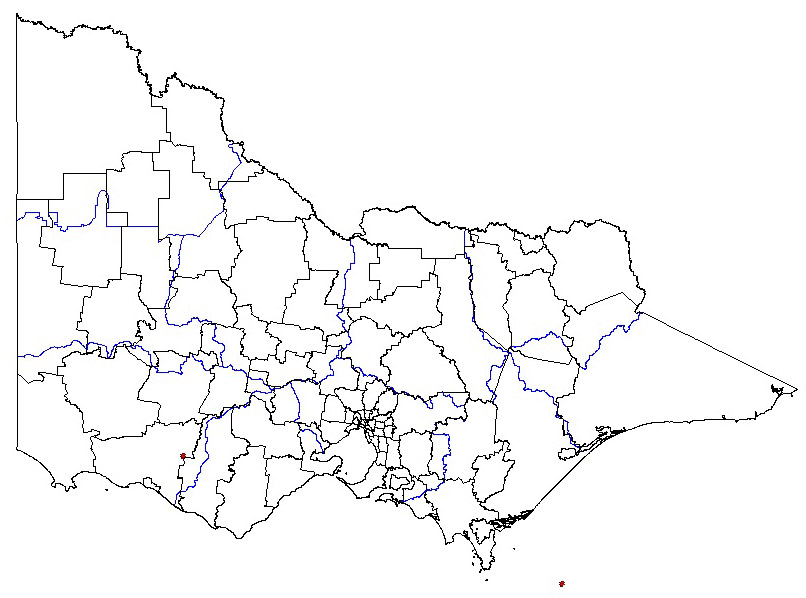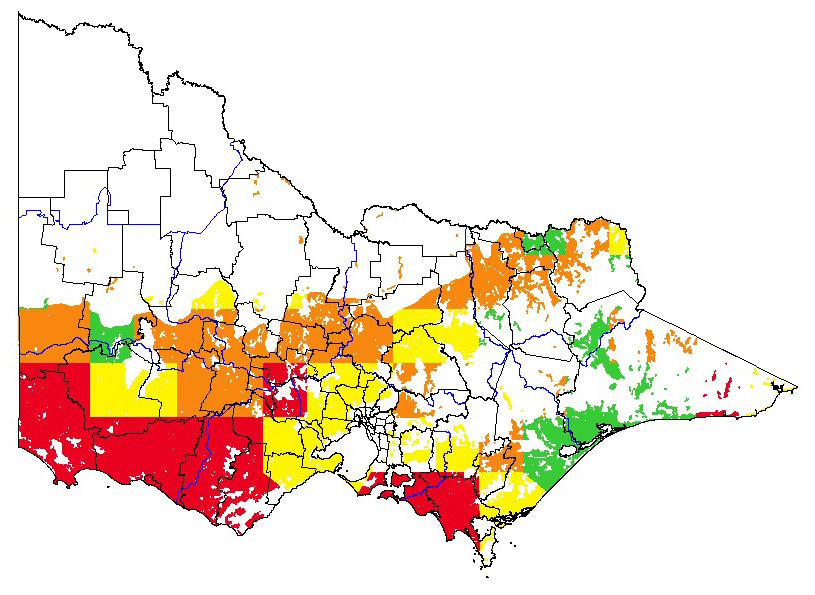Tree medick (Medicago arborea)
Present distribution
|  Map showing the present distribution of this weed. | ||||
| Habitat: Prefers rocky hillsides and steep cliffs, especially limestone and calcareous dry soils (Bennet, et al. ’06). Grows at less than 780 m altitude (Ibid.). It is particularly shade intolerant, so although it is listed as possibly found in Broad Vegetation Types that include woodland, it would be restricted to open patches. Annual rainfall of greater than 250 mm. (Ibid.) | |||||
Potential distribution
Potential distribution produced from CLIMATE modelling refined by applying suitable landuse and vegetation type overlays with CMA boundaries
| Map Overlays Used Land Use: Pasture dryland Broad vegetation types Coastal scrubs and grassland; coastal grassy woodland; heathy woodland; grassland; plains grassy woodland; wimmera / mallee woodland. NB. only in open patches. Colours indicate possibility of Medicago arborea infesting these areas. In the non-coloured areas the plant is unlikely to establish as the climate, soil or landuse is not presently suitable. | 
|
Impact
QUESTION | COMMENTS | RATING | CONFIDENCE |
| Social | |||
| 1. Restrict human access? | None recorded in literature review; no prickles, probably doesn’t cause impediment(s) | L | L |
| 2. Reduce tourism? | Not obvious to ‘average’ visitor. | L | L |
| 3. Injurious to people? | No | L | L |
| 4. Damage to cultural sites? | None recorded in literature review; but root damage may be a potential cause of damage as it is described in the literature as having well developed horizontal and vertical roots (REDMED) | M | L |
| Abiotic | |||
| 5. Impact flow? | Terrestrial species | L | M |
| 6. Impact water quality? | Terrestrial species | L | M |
| 7. Increase soil erosion? | Planted to mitigate soil erosion (Andreu et al., ’98) Root system highly developed horizontally and vertically (REDMED) | L | H |
| 8. Reduce biomass? | Biomass may increase due to high branch density (REDMED) | L | ML |
| 9. Change fire regime? | None recorded in literature review; but it may increase fuel load | L | L |
| Community Habitat | |||
| 10. Impact on composition (a) high value EVC | EVC = Coastal Headland Scrub (V); CMA = Glenelg Hopkins; Bioreg = Bridgewater; VH CLIMATE potential. May result in very little displacement of indigenous spp.; with sparse/scattered infestations along coastal rocky outcrops. | L | M |
| (b) medium value EVC | EVC = Coastal Saltmarsh (E); CMA = Corangamite; Bioreg = Victorian Volcanic Plain; H CLIMATE potential. May result in very little displacement of indigenous spp.; with sparse/scattered infestations along coastal rocky outcrops. | L | M |
| (c) low value EVC | EVC = Coastal Alkaline Scrub (LC); CMA = Glenelg Hopkins; Bioreg = Bridgewater; VH CLIMATE potential. May result in minor displacement of indicator spp. on alkaline soils. | ML | M |
| 11. Impact on structure? | In home range species only grows intermittently on very poor, calcareous rocky outcrops. Therefore it is expected to only have a minor, or negligible, effect on < 20% of present flora. | L | MH |
| 12. Effect on threatened flora? | None recorded in literature review | MH | L |
| Fauna | |||
| 13. Effect on threatened fauna? | None recorded in literature review | MH | L |
| 14. Effect on non-threatened fauna? | None recorded in literature review | M | L |
| 15. Benefits fauna? | Provides pollen (Ricciardelli, ’84) Preferred Sitona weevil food source (Dillon, ’03) Used as fodder by ancient Greeks and Romans (Bennett et al., ’06) High palatability to insects (Patabendige et al., ’92) | L | MH |
| 16. Injurious to fauna? | None recorded in literature review | L | L |
| Pest Animal | |||
| 17. Food source to pests? | Yes, to hares and rabbits (Cereti & Rossini, undated) | ML | M |
| 18. Provides harbor? | Yes, to hares and rabbits (Ibid) | MH | M |
| Agriculture | |||
| 19. Impact yield? | N-fixer via bacterial symbiosis, may increase N for crops (www.ibiblio.org) | L | ML |
| 20. Impact quality? | None recorded in literature review, not known as weed of crops | L | L |
| 21. Affect land value? | None recorded in literature review | M | L |
| 22. Change land use? | None recorded in literature review | M | L |
| 23. Increase harvest costs? | None recorded in literature review | M | L |
| 24. Disease host/vector? | None recorded in literature review | M | L |
Invasive
QUESTION | COMMENTS | RATING | CONFIDENCE |
| Establishment | |||
| 1. Germination requirements? | Seeds need pre-soaking (www.ibiblio.org) , but in wild regular mention that it grows best in dry, rocky, exposed sites (eg. Richardson et al. 2006). | MH | ML |
| 2. Establishment requirements? | Prefers rocky hillsides, steep cliffs, especially limestone; dry soil; <780m alt. (Bennet et al, ’06) Prefers neutral to alkaline soils (Patabendige et al., ’92) | ML | MH |
| 3. How much disturbance is required? | Naturalise in lawns, on roadsides, gardens, and other disturbed sites (Richardson et al. 2006) | ML | MH |
| Growth/Competitive | |||
| 4. Life form? | Legume (Ricciardelli, ’84) Perrenial (Bennet et al., ’06) | MH | H |
| 5. Allelopathic properties? | None recorded in literature review | M | L |
| 6. Tolerates herb pressure? | Highly susceptible to aphids (Bennet et al., ’03) Preferred food source of hares (Cereti & Rossini, undated) Lacks a crown (Bingham, ’04) | L | MH |
| 7. Normal growth rate? | Grows more slowly than other Medicago species (Bingham, ’04) | ML | MH |
| 8. Stress tolerance to frost, drought, w/logg, sal. etc? | Drought tolerant (Patabendige et al., ’92) NOT tolerant to salt or waterlogging (Ibid) Not frost, or shade tolerant (www.ibiblio.org) Shade intolerant (Cereti & Rossini, undated) | L | MH |
| Reproduction | |||
| 9. Reproductive system | Sexual (Ricciardelli, ’84) May self-pollinate, or cross-pollinate (Bingham, ’04) Hermaphroditic flowers(www.ibiblio.org) | ML | MH |
| 10. Number of propagules produced? | Large seeds (Bingham, ’04) 2-8 seeds/pod (Bennet et al, ’06) | L | MH |
| 11. Propagule longevity? | M | L | |
| 12. Reproductive period? | M | L | |
| 13. Time to reproductive maturity? | Two years to seed formation (Bingham, ’04) | ML | MH |
| Dispersal | |||
| 14. Number of mechanisms? | Actively planted as an ornamental (Bennet et al, ’06) Gravity; large seeds, not likely windbourne (Bingham, ’04) | L | MH |
| 15. How far do they disperse? | None recorded in literature review, but as large seeds that rely on gravity, probably not far. | L | L |
References
Andreu, V. Rubio, J.L. and Cerni, R. (1998) Effects of Mediterranean Shrub Cover On Water Erosion (Valencia, Spain). In: Journal of Soil and Water Conservation. 53: (2) 112 – 120.
Bennett, S.J., Ayres, J., Dear, B.S., Ewing, M., Harris, C., Hughes, S., Mitchell, M., Moore, G., Nie, Z., Reed, K., Sandral, G.A., Slattery, J., and Snowball, R. (2003) Perennial Pastures For The Recharge Areas of Southern Australia. In: CRC for Plant-based Management of Dryland Salinity. Pg. 15.
Bennett, S.J., Broughton, D.A., and Maxted, N. (2006) Ecogeographical Analysis of the Perennial Medicago. In: CRC Salinity Bulletin 1: 1 – 62.
Bingham, E.T. (2004) “Medicago arborea Project at University of Wisconsin, Madison. <http://www.medicago-reports.org/volumepdf5.htm>
Cereti, C.F., Rossini, F. (undated) Sowing and Planting of Medicago arborea in Mediterranean Maquis. Preliminary Observations. Instituto di Agrotecnica dell ‘Universita’ degli Studi della Tuscia, Viterbo, Italy.
Dillon, T. (2003) Salinity Pasture Trial; Trial Demonstration. In: Yield Prophet® Alkaline Soils Group Annual Results Book. Pg. 32 – 33.
Patabendige, D.M., Scott, P.R., and Lefroy, E.C. (1992) Fodder Trees and Shrubs For High Rainfall Areas of South Western Australia. In: Resource Management Technical Report # 135.
Plants For A Future: Database http://www.ibiblio.org/
Ricciardelli, D. A. G. C. (1984). Observations on the insects pollinating some Leguminosae (Onobrychis viciifolia, Lotus corniculatus, Medicago arborea, Medicago sativa) in a specialized area. In: Redia 67: 145-156.
Richardson, F.J., Richardson, R.G., and Shepherd, R.C.H. (2006) Weeds of the South-East; An Identification Guide For Australia. ISBN: 0 9587439 3 2.
REDMED web page http://www.gva.es/ceam/redmed/redmed.htm (2002)
Global present distribution data references
Australia’s Virtual Herbarium Distribution Data http://www.anbg.gov.au/cgi-bin/avhxml.cgi/transform/20744 [Accessed 25 October, 2006.]
Botanical Society of the British Isles. (2002) Global Biodiversity Information Facility webpage http://www.europe.gbif.net/portal/digit_viewer.jsp?taxonKey=175569&countryKey=0&res... [Accessed 25 October, 2006.]
Feedback
Do you have additional information about this plant that will improve the quality of the assessment?
If so, we would value your contribution. Click on the link to go to the feedback form.


